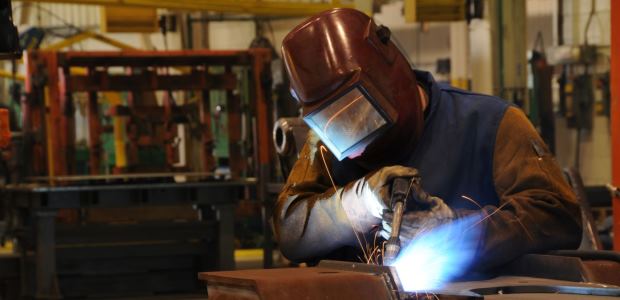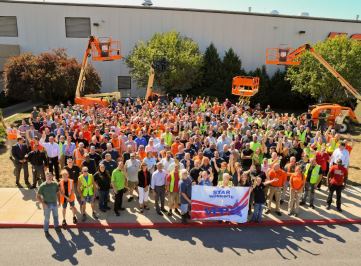
Making Safety Part of a Company's DNA
A comprehensive safety analysis should not be limited to the facility. It should also include a review of all tasks and processes, giving priority to high-risk areas.
- By Adam Croskey
- Sep 01, 2017
Written safety policies do not ensure a culture of safety at a company. Although putting a foundation of safety policies and best practices in writing is essential to a successful safety management system, a collection of policies alone cannot create an environment where employees feel safe and instinctively make safe choices.
Creating a culture of safety takes time and begins with real commitment from all levels of management—not just a Safety First sign as you enter the building or verbal commitment to safety by the CEO or facility manager, but an active commitment that leadership demonstrates every day in the decisions they make and the actions they take. Frontline supervisors set the tone because they have to make quick decisions throughout the day, including corrective action when a hazard is identified. Their first priority is safety.
 The decision to make safety a priority must be fully supported, encouraged, and rewarded by managers and executives to consistently reinforce that making safe decisions is most important among all levels of leadership. Taking action to correct unsafe conditions or using a positive approach to coaching team members on safe behavior deepens the internal commitment to following safe-work practices.
The decision to make safety a priority must be fully supported, encouraged, and rewarded by managers and executives to consistently reinforce that making safe decisions is most important among all levels of leadership. Taking action to correct unsafe conditions or using a positive approach to coaching team members on safe behavior deepens the internal commitment to following safe-work practices.
Fostering a culture of safety also requires a facility that is clean, organized, and well maintained. It is difficult to expect employees to commit to safe-work practices if the facility in which they work is dirty, unorganized, and in disrepair. On the contrary, employees are much more likely to feel their company values safety and remain engaged to continue to work safely if the environment around them is well-lit, orderly, and properly maintained and if signage clearly indicates safety requirements and expectations and employees are provided with high-quality safety equipment and personal protective equipment, when necessary.
Third-Party Evaluation Provides a Benchmark
To begin to understand where a facility is in its journey to provide a safe environment, it makes sense to engage a third party to visit a workplace, provide an unbiased facility safety evaluation, and gauge the safety culture of the organization through safety behavior observation and employee interviews. Too often a company functions under the “we’ve always done it this way” mantra or has become blind to unsafe working conditions or hazards hidden in plain sight.
Safety consultants, insurance representatives, corporate safety teams, Occupational Safety and Health Administration (OSHA) compliance specialists, industry peers, and other companies that participate in OSHA’s Voluntary Protection Program (VPP) are well equipped to conduct a safety audit to provide a company with a benchmark, indicating where the company can improve or where it excels.
A comprehensive safety analysis should not be limited to the facility. It should also include a review of all tasks and processes, giving priority to such high-risk areas as fall protection, lockout/tagout, confined spaces, electrical safety, lifting and rigging, and heavy equipment use, because failures in those areas can have serious consequences. Evaluate the hazards of each task and develop safe solutions to correct them. This means phasing out "we have always done it this way" processes and replacing them with best practices that use hazard analysis as a guide for development of new work processes. It also means implementing solutions to ensure the right equipment is being used for the right job. For example, if a company is striving to prevent falls, which are consistently one of the most frequently cited OSHA violations and a serious hazard in any line of work, an extension ladder or makeshift scaffold may not be the best choice for workers who need to use hand tools to access a motor or filter high above the shop floor.
Employee Engagement is Key
If a company wants to have success in safety, it is critical that it actively engage its employees to ensure that a strong safety culture can survive and grow. This means sharing the vision for safety and inviting and encouraging each employee to participate in shaping and achieving that vision.
Employee engagement can be accomplished in a number of ways, beginning with the establishment of employee-led safety committees and inviting all team members to join the committees. Participating in regularly scheduled meetings puts the pulse of shop floor employees in front of any safety initiative. Companies can also provide employees the opportunity to become voluntary first responders who are trained in emergency first aid, CPR, the use of automated external defibrillators, and other emergency response protocols.
Other employee engagement activities also contribute to a culture of safety, among them safety poster or calendar contests that employees can share with their families, small work teams for identifying and making safety improvements through facility safety audits or safety behavior observations, safety mentor programs that assign mentors to new team members, or, in the case of JLG Industries, Inc., a Safety Action Tracker. This program tracks safety opportunities as employees identify them, providing a description of the item and a photograph if one is available, describing the corrective action to be taken, identifying a target date for completion, and assigning an employee responsibility for taking the corrective action. This information is posted and available to all employees, supporting transparency, encouraging communications, and directing the appropriate resources to make a safety improvement in a timely manner.
JLG Industries also engages employees in activities designed to identify workers performing tasks in awkward postures or positions where ergonomics could be improved. The goal is to recognize these situations and propose solutions to remedy them. Additionally, these small work teams identify opportunities, such as maintaining work material within a self-regulated "power zone" of 15 to 60 inches. Known as the 15/60 rule, this rule ensures no product or materials necessary to perform a manufacturing job require an employee to reach down below 15 inches or above 60 inches. This simple guideline can improve ergonomics, while providing a well-organized and safer workstation.
Training Supports a Culture of Safety
Ongoing education and training also support a culture of safety. Although employers can develop their own safety training programs, OSHA offers a number of training resources for both employers and employees. The OSHA Outreach Training Program provides training for workers and employers on the recognition, avoidance, abatement, and prevention of safety and health hazards in workplaces. Through this program, workers can attend 10- or 30-hour classes delivered by OSHA-authorized trainers. The 10-hour class is intended to provide workers with awareness of common job-related safety and health hazards, while the 30-hour class is more appropriate for supervisors or workers with some safety responsibility.
Of even greater value are hands-on training programs that simulate the work environment. Programs like this provide training essentials in a setting that mimics the workplace but eliminates workplace pressures. They are especially useful as part of new employee training programs that teach job skills and ergonomic practices prior to an employee’s introduction to the production environment.
VPP Assesses Safety and Health Systems
Companies that want to be recognized for their commitment to workplace safety can participate in OSHA’s VPP. It sets performance-based criteria for a managed safety and health system, invites sites to apply, and then assesses applicants against these criteria. OSHA's verification includes an application review and a rigorous on-site evaluation by a team of OSHA safety and health experts. OSHA approves qualified sites to one of three programs:
- Star: The Star Program is designed for exemplary work sites with comprehensive, successful safety and health management systems.
- Merit: Merit is an effective stepping stone to Star. Merit sites have good safety and health management systems, but these systems need some improvement to be judged excellent. Merit sites demonstrate the potential and the commitment to meet goals tailored to each site and to achieve Star quality within three years.
- Demonstration: The Star Demonstration program is designed for work sites with Star-quality safety and health protection to test alternatives to current Star eligibility and performance requirements. Star Demonstration program participants are evaluated every 12 to 18 months.
Always Evaluate and Re-Evaluate
Whatever path a company chooses to follow as it strives to create a culture of safety, it is important to constantly monitor and evaluate the programs in place to ensure they are meeting the established benchmarks. It's all about creating an environment that attracts new employees with the same safety mindset, while ensuring the safety of current employees—an evolving environment where safety is second nature to all employees and leadership, ingrained in their DNA, influencing every decision they make and action they take. In the end, a rigorous, comprehensive safety program, endorsed by management and employees alike and assessed by third-party experts, can help organizations achieve constant, continuous improvement.
This article originally appeared in the September 2017 issue of Occupational Health & Safety.